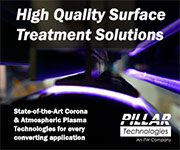Doctor Blades: Making the Most of Mission Critical
- Published: March 01, 2001, By Teresa Koltzenburg, Senior Editor
“Doctor blades are mission critical,” asserts Tom Allison, president of Allison Systems Corporation, Riverside, NJ. In today's converting/printing products “solution” profusion — and PFFC is as guilty as the rest with our “Web Solutions” and “Digital Solutions” — it's refreshing to hear a product be referred to as something other than a “solution,” at least in the descriptive sense.
Allison's colorful assertion of doctor blades as “mission critical” emphasizes the importance of their proper use. “A very small doctor blade problem can fill up dumpsters with printed waste and cost [converters] millions,” he maintains.
These blades (often comprising a metal alloy or metal/plastic composite) are utilized in both printing and coating applications, but their “mission critical” status is one that package printers probably would agree with the most.
“Doctor blades are used to wipe or meter the surface clean, so they are delivering a consistent ink film to the substrate,” says Anthony Foley, national marketing manager at Edward Graphics US Inc., Niagara Falls, NY. “On either a [flexo or gravure press], typically they are located right in the printhead and make physical contact with the engraved cylinder in rotogravure and the anilox roll in flexo printing.”
And this consistency is very important, notes Allison. “You need to have a very repeatable doctor blade system. Say you have a pile of printed fertilizer bags [displayed for retail]. This particular print job — each fertilizer bag package — has halftones, [elaborate] graphics, etc. I mean, this is a very difficult and demanding print job. Shade variation and graphics should appear uniform; if they don't, it makes the product look bad. Controlling the doctor blade action — which can affect color and shade variation across the web — is key. If you don't, you can have problems with streaks and localized vignettes.”
But fear not, Converting Comrades: This mission critical piece, the doctor blade, is getting better and better. “These days, there's a greater focus on the chemical composition of the metal from which the blade is manufactured,” explains Foley. “The requirements for doctor blades are very stringent: The steel has to be very clean or pure, what we call “inclusion-free,” meaning there are no contaminants. These contaminants, primarily phosphorus and sulfur, can have a negative effect on the surface of the print cylinder by scratching, scoring, or damaging it.”
In addition to a more “pure” construction, doctor blades are being used in conjunction with chambered systems that also contribute to overall end product quality and higher productivity. “Because today's coaters and printing converters are forced to do smaller runs, the makeready and changeover times are that much more important,” says Scott Michels, VP of sales, Harris & Bruno Machine Company, Roseville, CA. “With the chambered doctor blades in an automated wash-up system, both appearance and productivity benefit.”
Using doctor blades improperly, however, can cause as many problems — maybe even more — than not employing them at all, notes Foley. He explains, “There's definitely a lack of press operator training in terms of proper blade settings, adjustments, and so forth. The industry itself is so busy that people don't go through a proper apprenticeship cycle, and six months after joining a company, operators are running a two- to three-million dollar press with no formal training.”
To combat this, says Foley, on-line training is something Edward Graphics is looking into delivering to its customers. “Operators would visit a doctor blade cyber classroom, and here they could ask questions or see a PowerPoint or video presentation of blades being set, removed, and adjusted. The big advantage of on-line training is it's user friendly for both sides: The blade supplier doesn't have to travel thousands of miles, and from the operators' perspective, they can fulfill their main duties of running the press and do this at home or at a time that's convenient at work.”
It's well worth a doctor blade user's time to ensure proper blade adjustment and to consider the latest developments in both technology and training. Without doing either, mission critical easily could turn into mission impossible.













